Top News
July 12, 2019 Ryukyu Shimpo
The current situation wherein we cannot even conduct an investigation into environmental problems that could very well threaten the lives and livelihoods of Okinawans is one that we cannot approve of. The Japanese government must quickly pursue an effective policy that will allow such surveys to be conducted on the grounds of U.S. bases.
The Okinawa Defense Bureau (ODB) requested permission to enter Kadena Air Base in order to conduct a survey to check for water pollution due to organic fluorine compounds, but were denied; the ODB’s abandonment of the survey was discovered via a right-to-know request.
Organic fluorine compounds come in many varieties. PFOS, PFOA are just a few of them. These are widely used in the making of water repellant materials and as a fluorine resin for coating instruments. They do not decompose easily in nature, and will accumulate over time.
They are indicated as a health risk, both as a potential carcinogen and as a source for developmental disorders. The manufacture, use, and export of these materials are restricted by international treaty.
It was confirmed that there was contamination in Okinawa both in underground water sources as well as in rivers. As a result people have stopped using tap water, and have instead begun requesting safe drinking water that is sold commercially in PET bottles.
While there are not determined regulation levels in Japan, it is without a doubt a problem for the health of Okinawans. Even without a disclosure request, Japan should be able to make such things known to the public just from their regular interactions with the U.S. military. We would like if public officials remembered that their role is to be “in service to everyone.”
The ODB requested access to the base from the U.S. military in 2017 and 2019, but were denied. The incremental increase of instances where Japan is required to obtain permission from the U.S. military is due to the fact that the U.S. has exclusive authority over the Japan-U.S. Status of Forces Agreement (SOFA).
The environmental clarification of SOFA signed in September of 2015 is only just starting to take shape. At the time of the signing, Prime Minister Shinzo Abe said proudly, “We were able to effective enact a revision to SOFA.”
However, the ODB this time did not request to enter the base to conduct a survey, a right based on the environmental clarification in SOFA. The hurdles to clear the requirements for entry proved to be too high.
In addition to the prerequisite that the U.S. will provide Japan with information regarding and environmental incident, there is also a requirement that states, “[Access is] limited to cases where the U.S. has judged that entry will not be an impediment to U.S. military operations.”
The U.S. has sole discretion to accept or deny these applications, and it is seen as quite difficult to meet all of the requirements. It is clear that this was a supplemental agreement in name only. There have been many agreements reached between Japan and the U.S., but their effectiveness has been dismal.
It has been three years since the water pollution problem was detected. Even the Japanese government themselves have not been able to enter to conduct a survey. Japan has failed to see the requests of Okinawa through to completion.
In Germany, municipalities have the right to enter bases without prior notification. As a sovereign nation, Japan should also aim to revise SOFA with this goal in mind.
We ask that both Japan and Okinawa take a shared stance on the problem of delivering all of the information collected to Okinawans. It is imperative that a concrete plan is put together to stop the source of the pollution.
(English translation by T&CT and Sam Grieb)
Go to Japanese
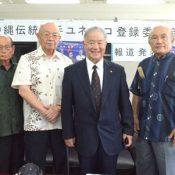
July 11, 2019 Ryukyu Shimpo
The Committee for Okinawa Karate UNESCO Listing was recently formed with the goal of getting Okinawa Karate registered as an intangible cultural asset with the United Nations Education, Scientific and Cultural Organization (UNESCO). The committee members gathered July 10 at the Okinawa Prefectural Office’s press club in Naha to hold a press conference, where they announced that they were planning on developing a plan to have Okinawa Karate inscribed on the list as a “ritual.”
The committee’s chair, Morio Higaonna, emphasized, “Okinawa Karate is designated as an intangible cultural asset by Okinawa Prefecture, and is an Okinawan treasure left by our ancestors. Under the leadership of Okinawa’s governor, we have joined Karate-ka from four different schools with the prefecture into a single organization, and we want to see [Okinawa Karate] inscribed [on the intangible cultural assets list].”
Committee manager Masaki Sunagawa said regarding having the martial art listed as a ritual, “The available genres in UNESCO’s Convention Concerning the Protection of the World Cultural Heritage does not include ‘martial arts’ or ‘sports,’ so if we were to apply for it as a martial art it would not be recognized.” He explained that they were applying to have it listed in the “societal custom, ritual, and spiritual festival” category.
The committee chose as its’ slogan, “The spirit of peace; tying the ritual of Okinawa Karate to the UNESCO ring,” and are developing a strategy around martial arts festivals and ritual martial arts demonstrations, as well as an survey of ritualistic Karate literature and locations. While they are still investigating the length of time it will take to get Okinawa Karate inscribed, Higaonna said, “It is necessary that not just Karate-ka but also Okinawans band together to realize the goal.” Here are the members of the committee:
Committee Chair Morio Higaonna (International Gojuryu Karate Organization Grand Master), Director Zenpo Shimabukuro (International Okinawa Syorinryu Seibukan Karate-do Association President), Minoru Higa (Okinawa Shorinryu Karate-do Kyudokan Association President), Tsutomu Nakahodo (Uechi-ryu Okinawa Karate-do Association Senior Advisor), Masakazu Kuramoto (International Gojuryu Karate Organization President), and Dr. Masaki Sunagawa (Nambu Hospital).
(English translation by T&CT and Sam Grieb)
Go to Japanese
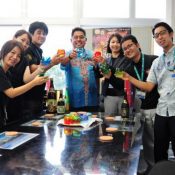
July 10, 2019 Ryukyu Shimpo
An auspicious custom with awamori.
On July 9, in hopes of passing on the culture of and to promote Ryukyu awamori, the Yonabaru Town Council unanimously agreed on Okinawa Prefecture’s first “ordinance that promotes toasting with Yonabaru Town’s Ryukyu awamori” during their extraordinary meeting.
The ordinance also went into effect on the same day.
The hope is that while observing alcohol consumption etiquette and respecting individual preferences, this ordinance will appeal to townspeople and businesses to toast with Ryukyu awamori, which will lead to expanded consumption. Mayor Tsutomu Teruya said, “We’d like to toast with awamori during the town’s official events as much as possible.
Younger people may dislike it without even having tried it, so with the establishment of this ordinance, we want to increase the number of opportunities for them to familiarize themselves with awamori culture.”
Since there are 125 active toasting ordinances for sake and shochu in all of Japan, the Okinawa Prefecture Liquor Manufactures Association and Masahiro Brewery had submitted an appeal to Yonabaru City, which had a factory before the war, and Itoman City, which has the current factory, to request the establishment of an ordinance.
Yonabaru City unanimously agreed during the regular meeting in June and the ordinance was established.
As for the Itoman City Council, although the Uehara Brewery also filed the appeal under a joint signature, the council continues to deliberate.
The said ordinance promotes toasting with Ryukyu awamori, which are in a downward trend in terms of shipment, and passes on the awamori culture to the next generation.
The hope is that the town, businesses, and townspeople all individually play a part in this, which will lead to industrial development and regional revitalization.
Okinawa Prefecture Liquor Manufactures Association Managing Director Shinken Tsuchiya happily said, “Ryukyu awamori is Japan’s oldest distilled alcohol and is Okinawa’s tradition.
‘Let’s start off with some beer for now’ is good too, but I hope that this will turn into ‘Let’s start with some awamori for now.’(The establishment of this ordinance) should lead to an expansion in awamori consumption focusing in Yonabaru.”
Masahiro Brewery President Masakuni Higa said, “It is my mission to protect and pass on awamori. I appreciate that people are showing they understand that. ”
(English translation by T&CT and Chelsea Ashimine)
Go To Japanese
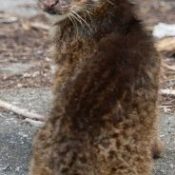
July 10, 2019 Ryukyu Shimpo
Recently, Assistant Professor Takuto Shitara of the Iriomote Station at the University of the Ryukyus Biosphere Research Center succeeded in photographing an Iriomote cat kitten.
Iriomote cats are Special Natural Monuments of Japan, peculiar to Taketomi Town on Iriomote Island.
They are nocturnal and generally do not appear to humans. Shitara said, “No one is more surprised than I am that such an opportunity arose.”
According to Shirata, the photograph was taken on June 30.
While he was driving he saw an adult Iriomote cat near a gutter on the other side of the road.
The cat quickly disappeared into the brush, but next, its kitten came out of a nearby gutter.
The kitten seemed to look for its parent, then made its way toward the brush.
Last year, traffic accidents involving Iriomote cats reached a record high of 9 incidents annually.
Shitara, who specializes in flora, said, “I will be happy if people who see the picture become more aware about the protection of nature.”
(English translation by T&CT and Erin Jones)
Go To Japanese
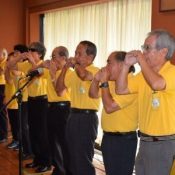
July 16, 2019 Ryukyu Shimpo
Hiroki Ohashi
Okinawa’s finger-whistling music can be heard cheering on the teams at high school baseball games and at Eisa performances. On July 7, Finger-Whistling Day, a “Summer Vacation Finger-Whistling Concert 2019” was held at the JICA Okinawa International Center in Urasoe, Okinawa.
The performers played ten songs, including “Shimanchu nu Takara” and “Eikan wa Kimi ni Kagayaku,” using only their fingers.
The dining hall, filled with interns from various countries and other customers, echoed with the uniquely Okinawan sound of finger-whistling music.
Finger-Whistling Day was designated in 2006.
July 10 was chosen as the date because finger-whistling is performed using all ten fingers bent in the shape of the number 7, and because it is often played at summer events like high school baseball games and Eisa performances.
Members of the finger-whistling-lovers group “Yubibue Okoku Okinawa (Okinawa, Land of Finger-Whistling)” gave the performance.
The group was formed in 2005, and has worked for the last 14 years to convey the charm of finger-whistling music.
A male company worker, age 38, from Naha who attended the performance said, “I can’t even make a sound when I try to finger-whistle. The high rising tone sounds fun, and I was surprised that they could use the sound to make such great music.”
“I want people to enjoy Okinawa’s culture and the rich expressiveness of finger-whistling. I want people to pass the hot summer in good spirits by listening to finger-whistling,” said Yubibue Okoku Okinawa’s “king,” Joji Kakinohana.
Yubibue Okoku Okinawa will perform a charity concert called “15th Fun World of Finger-Whistling” at 3 p.m. on July 21.
The concert will be held to support areas stricken by the natural disasters that have been occurring throughout Japan recently, and profits as well as donations collected at the venue will be sent to victims of the disasters.
The location will be the Tedako Small Hall in Urasoe. Tickets purchased in advance and on the day of the concert are all 999 yen.
For more information, contact Kakinohana at 090-9783-9066.
(English translation by T&CT and Sandi Aritza)
Go To Japanese
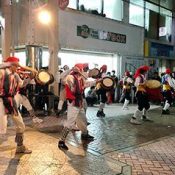
July 08, 2019 Ryukyu Shimpo
Koza City, known as “the military-base town”, is a microcosm of Okinawa. Okinawa City Tourism and Promotion Association has worked to allure visitors locally and from afar, under its president, Takashi Shimabukuro.
The association began receiving class trips and group tours exactly a decade ago, and looked back on its track record at this 10-year milestone.
The number of group tours they receive grew over the years, surpassing 100 groups in the fiscal year 2018. A popular magazine, published every ten days, featured Koza in a 30-page special in one of their May issues, titled: “Koza on fire–a hotspot among locals in the know.”
Thanks to the spread, Koza has gained national attention as a novel town in which visitors can pay in U.S. dollars.
Okinawa City has an exotic atmosphere, with its own unique champuru (melting pot) culture. Yet still, the area used to be ignored by tourist busses headed to the northern parts of the island.
The tourism association focused on the presence of Kadena Air Base, and Koza’s condensed post-war history.
It adopted the theme, “Post-war era here and now” for the town. The town’s role as a host to military bases provides a unique and authentic pacifist education opportunity for tourists.
In addition, the association looked further for material to entice visitors, and put together a wide-ranging list of tourist attractions, including cultural activities such as eisa dance, sanshin guitar, karate, cane sugar making, historic tours, Gate 2 street tours, shopping around the Goya intersection, TV and film location tours, and night-time tours of live performance venues featuring rock-n-roll and traditional music.
Koza is also gaining traction thanks to the Naoki-prize winning novel, “Takarashima”, which centers around the Koza Riots, and the hit movie, “Chiisana Koi no Uta.”
The association’s tireless promotional efforts have paid off. The organization started receiving group tours with just one group comprising 120 visitors.
The number grew over the years, and in fiscal year 2018, they welcomed 107 groups, representing 9000 visitors.
Middle school and high school class trips from the main islands are specific areas of growth. Kanagawa prefecture’s Eiko Gakuen has brought its students to Okinawa 10 years in a row.
Since 2013, the Okinawa City Tourism and Promotion Association has been giving annual seminars to train licenced volunteer tour guides, and currently boasts a roster of around 60 guides.
Yoko Irei, a tour guide who was trained in the very second seminar, said that visiting students often arrive “scared by the idea of a military-base town, but through our guided tours, they realize it’s a city where different cultures coexist.
They leave with the realization that it’s a friendly town.”
Kazusei Yamada, the association’s executive officer, addressed future challenges in earnest: “We’d like to enrich the current program; set our sights on inbound tourism and offer walking tours and cultural activities to our foreign visitors as well.”
(English translation by T&CT and Monica Shingaki)
Go To Japanese

July 9, 2019 Ryukyu Shimpo
In June, a plan by the NPO Ichiman-nin Idobata Kaigi, which runs the Hantagawa Community Center in Naha, Okinawa, to build community centers in Egypt was adopted by the Ministry of Education, Culture, Sports, Science and Technology (MEXT) as a “project for promoting Japanese-style education overseas.”
With the ministry’s support, the NPO will open its first community center, which will serve as a model for others, in Cairo as early as January or February 2020.
The community center will be run jointly by the NPO and Mohamed Abd-el Meguid (known as Guid), who learned about the role of community centers at the Hantagawa Community Center.
Guid grew interested in education in various countries when he participated in the Cabinet Office’s international exchange project in 2004.
From 2011 to 2015, he lived with his wife Miyuki in her homeland of Okinawa, and after returning to Egypt he worked together with the Ichiman-nin Idobata Kaigi with the aim of opening community centers in Egypt.
Egypt experiences great inequality, and statistics show that literacy stands only around 20%.
Shinnosuke Minami, director of the Hantagawa Community Center and representative boardmember of the Ichiman-nin Idobata Kaigi, says, “There is a need for community centers as a place where anyone can go to learn.”
The group also plans to work on instilling a culture of mutual cooperation and supporting self-actualization by helping youth find work and the like.
“Japanese community centers also fail to support youth well. The community center we build in Egypt will also serve as a model for the kind of community centers that are needed in Japan,” says Minami.
The community center to be built in Cairo will be built near schools, and will aim to partner with the schools.
It will also partner with local universities to educate people who can support the community center.
MEXT will provide financial support for two years, during fiscal 2019 and 2020. After that, Guid will run the community center.
(English translation by T&CT and Sandi Aritza)
Go To Japanese
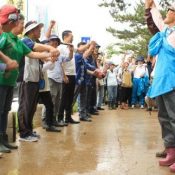
July 6, 2019 Ryukyu Shimpo
On July 6 about 350 people gathered in front of a Camp Schwab gate, demonstrating their opposition to the construction of the Futenma Replacement Facility (FRF) in Henoko, Nago City, for the relocation of Marine Corps Air Station Futenma (MCAS Futenma).
This was the first weekend following the announcement of the House of Councillors election, and attendees included supporters of the candidate endorsed by the FRF-opposing All-Okinawa camp, Tetsumi Takara.
Participants made statements such as, “We will not excuse the oppression of the administration, which is forcing base construction through.”
July 6 marks the beginning of the sixth year since Camp Schwab gate sit-ins began, and a large-scale protest rally was planned for this juncture.
However, rainfall started in the morning and went on into the day, interrupting the planned rally. Even with the rainfall, citizens began trickling in around 9:00 a.m. and gathered in front of the gate.
They expressed the purpose of their protest through activities such as singing songs criticizing the Japanese government’s stance on FRF construction.
Director Hiroji Yamashiro of the Okinawa Peace Movement Center said, “Even though we were not able to have a large-scale rally, it’s good we were able to raise our voices together with our colleagues to observe the day the fight began.”
(English translation by T&CT and Erin Jones)
Go To Japanese
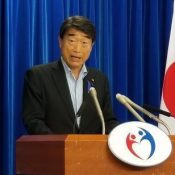
July 9, 2019 Ryukyu Shimpo
Toyko – The Japanese government decided July 9 not to appeal a ruling by the Kumamoto District Court that recognized that as part of the government’s quarantine policy for those afflicted with Hansen’s disease, not only the afflicted but also the families suffered discrimination.
Minister of Health, Labour and Welfare Takumi Nemoto said at a press conference the same morning, “[Prime Minister Shinzo Abe] has indicated that we cannot prolong the suffering of these families who have painstakingly relived their stories to the point of exhaustion.
We have received instruction to explore withdrawing the appeal.”
Nemoto also commented, “There are details within the ruling that are hard to accept,” and stressed that there was an extraordinary handling of the case.
Meanwhile, the decision did not find Japan at fault regarding their isolation policy enacted in Okinawa prior to its reversion to Japan.
When asked about compensation for those who were affected in pre-reversion Okinawa, Minister Nemoto only said, “I would like to refrain from commenting.”
(English translation by T&CT and Sam Grieb)
Go To Japanese

July 3, 2019 Ryukyu Shimpo
The Okinawa Prefectural Government (OPG) has decided to propose to the Okinawa Prefectural Assembly an ordinance to protect scarce prefectural wildlife, due to the poaching and exploitation of Okinawa’s wildlife.
Because there are many rare forms of wildlife peculiar to Okinawa, and because enforcing regulations on species under current conservation laws is largely unattainable, the aim is to protect these species through an independent ordinance.
There is hope that this will also lead to the registration of the northern part of Okinawa Island and Iriomote Island as a World Natural Heritage site, and increased environmental protection.
Although enactment of this ordinance has been pursued since 2006, it has been delayed due to concerns such as difficulties with designating which species to protect.
Director General Norimi Tanahara of the Okinawa Prefectural Department of Environmental Affairs answered inquiries at the Prefectural Assembly, and expressed his intention to propose the ordinance and hope it would be enacted this fiscal year.
Assembly member Masataka Jiroku of the Social Democratic Party and Okinawa Social Mass Party coalition asked the questions.
On June 28 the Okinawa Department of Environmental Affairs’ Nature Conservation Division put the ordinance proposal on its website’s home page and enabled public comments.
Currently, national laws such as the Act for the Conservation of Endangered Species of Wild Fauna and Flora regulates the capture of 55 species of scarce wildlife in Okinawa.
Out of the 1237 species separated into 10 classes on the Threatened Wildlife in Okinawa (Red Data Okinawa) list, those regulated under law had been narrowed down based on experts’ opinions.
Okinawa’s proposed protection ordinance would greatly expand the number of species regulated.
The OPG plans to consult with the Prefectural Nature Conservation Council concerning which species to regulate under the ordinance.
The proposed ordinance will ban capturing, harvesting, killing, or harming specified scarce wildlife, will establish the penalties for these actions, and will designate some habitats as sanctuaries.
Also, the ordinance is expected to include measures relating to some of the 371 species on the invasive species list, banning actions such as releasing, planting, or distributing select types.
(English translation by T&CT and Erin Jones)
Go To Japanese
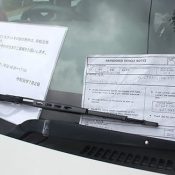
July 4, 2019 Ryukyu Shimpo
Local residents who oppose Northern Training Area (NTA) helipads have set up tents, tent furnishings, simple toilets and other items as part of their opposition in front of the NTA’s N1 zone gate.
On July 2 the U.S. Marine Corps in Okinawa removed these tents and furnishings.
This is not the first time it has done so.
Cars parked there were posted with notices that the cars would be impounded within three days if not moved. Residents made plans to visit the Okinawa Defense Bureau (ODB) on July 5 to object to these actions by the Marine Corps.
The U.S. Marine Corps told the Ryukyu Shimpo that it had notified the tents’ owners of the date by which it would remove the tents, and had waited until that date to do so.
It claimed that because the tents were left there, it had removed them based on the U.S.-Japan Status of Forces Agreement.
Similarly, the ODB answered that the U.S. military gave notifcation about removal of these items.
Tents and other items were removed without notification in April, and this was the second such time since then.
At the end of April the U.S. Marine Corps posted notices on residents’ setups, and removed them at night on July 2 when the residents were absent. The residents became aware their setups had been removed at about 8:30 a.m. on July 3.
Noboru Gibo, 64, was the first person to confirm the tents had been removed.
He said: “[The military] was unable to remove [things] during the day and did it at night because the U.S. military, too, seems to know this is not behavior that can be exhibited publicly.
We must not give up; we will continue to protest.”
(English translation by T&CT and Erin Jones)
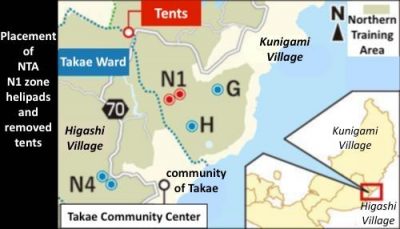
Go To Japanese











 Webcam(Kokusai Street)
Webcam(Kokusai Street)


